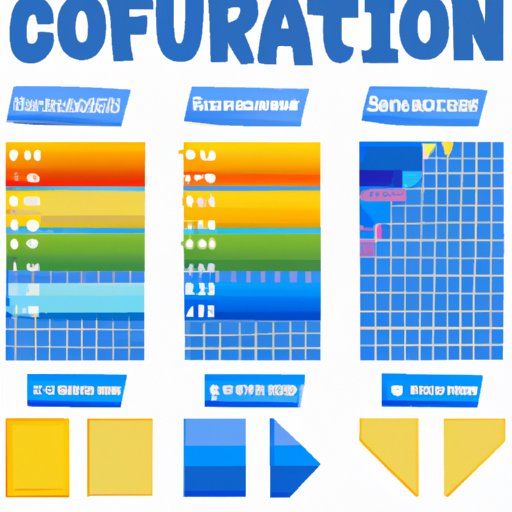Introduction
Do you struggle with converting fractions to decimals? You’re not alone! Converting fractions to decimals can be a challenging task, especially if you don’t know where to start. But don’t worry! In this article, we’ll guide you through the process of converting fractions to decimals, step-by-step. Whether you’re a student, a chef, or an engineer, this guide is designed to help you master the art of fraction/decimal conversion.
Step-by-Step Guide
Before we dive into the methods of converting fractions to decimals, let’s take a brief look at how decimals work. A decimal is a way of writing a number that is not a whole number, using a point (called a decimal point) to separate the integer part from the fractional part. For example, the decimal form of the fraction ½ is 0.5. Now, let’s move on to the step-by-step guide:
Method 1: Long Division
Long division is a popular method for converting fractions to decimals. Here’s how it works:
Step 1: Write the fraction as a division problem, with the numerator on top and the denominator on the bottom.
Step 2: Divide the numerator by the denominator, and write the quotient (the result of the division) as a whole number.
Step 3: Multiply the remainder (if any) by 10, and write it as the new numerator.
Step 4: Continue this process until you have the desired number of decimal places.
Let’s use the fraction 3/4 as an example:
3 ÷ 4 = 0.75
So, 3/4 in decimal form is 0.75.
Method 2: Fraction to Decimal Chart
Another way to convert fractions to decimals is by using a chart. Here’s how it works:
Step 1: Find the fraction you want to convert in the chart.
Step 2: Read the decimal equivalent in the same row as the fraction.
Here’s an example:
Fraction Decimal
1/2 0.5
3/4 0.75
7/8 0.875
Method 3: Shortcut
Some fractions can be converted to decimals using a simple shortcut. Here’s how it works:
Step 1: Divide the numerator by the denominator.
Step 2: If the resulting decimal terminates (ends), you’re done.
Step 3: If the resulting decimal repeats, put a bar over the repeating digits.
Here’s an example:
5/9 = 0.555…
So, 5/9 in decimal form is 0.555 with a bar over the five.
Chart or Infographic
To make fraction/decimal conversion even easier, we’ve created a chart that covers a range of fractions, mixed numbers, and repeating decimals. Here’s a preview:
Fraction Decimal
1/2 0.5
1/3 0.333…
2/3 0.666…
1/4 0.25
3/4 0.75
1/5 0.2
2/5 0.4
3/5 0.6
4/5 0.8
1/6 0.166…
5/6 0.833…
1/8 0.125
3/8 0.375
5/8 0.625
7/8 0.875
Mixed Number Decimal
1 1/2 1.5
2 3/4 2.75
3 1/3 3.333…
4 2/5 4.4
Repeating Decimal Fraction
0.3333… 1/3
0.6666… 2/3
0.1252525… 5/39
0.121212… 4/33
Video Tutorial
If you prefer a more visual approach to learning, we’ve created a video tutorial that walks you through the step-by-step process of converting fractions to decimals. Here’s a sneak peek:
The video covers common questions and problems that may arise during the conversion process, and uses a variety of visual aids and examples to make the process easy to follow.
Common Mistakes to Avoid
When it comes to converting fractions to decimals, there are a few common mistakes that people make. Here’s how to avoid them:
Mistake #1: Forgetting to divide the numerator by the denominator.
Why it’s a mistake: Dividing the numerator by the denominator is the first step in converting a fraction to a decimal.
How to avoid it: Double-check your work to make sure you’ve divided the numerator by the denominator.
Mistake #2: Dividing by the wrong number.
Why it’s a mistake: If you’re dividing by the wrong number (for example, dividing the denominator by the numerator), your answer will be incorrect.
How to avoid it: Double-check your work to make sure you’re dividing the numerator by the denominator.
Mistake #3: Not simplifying the fraction first.
Why it’s a mistake: If you don’t simplify the fraction first, you may end up with a more complicated decimal than necessary.
How to avoid it: Simplify the fraction first by dividing both the numerator and the denominator by their greatest common factor.
Real-World Applications
Knowing how to convert fractions to decimals is useful in a wide range of real-world situations. Here are a few examples:
Cooking: Recipes often require fractions of measurements, like 1/2 cup of flour. If you want to double or halve a recipe, you’ll need to know how to convert those fractions to decimals.
Engineering: Blueprints often use fractions to indicate dimensions. If you’re an engineer, you’ll need to be able to convert those fractions to decimals to make accurate measurements.
Stocks: If you’re investing in the stock market, you’ll need to be able to convert stock prices (which are often expressed as fractions) to decimals.
Conclusion
Converting fractions to decimals may seem daunting at first, but with practice and the resources provided in this article, you’ll soon be a conversion pro. Remember to double-check your work, avoid common mistakes, and practice converting fractions to decimals in a variety of real-world situations.
